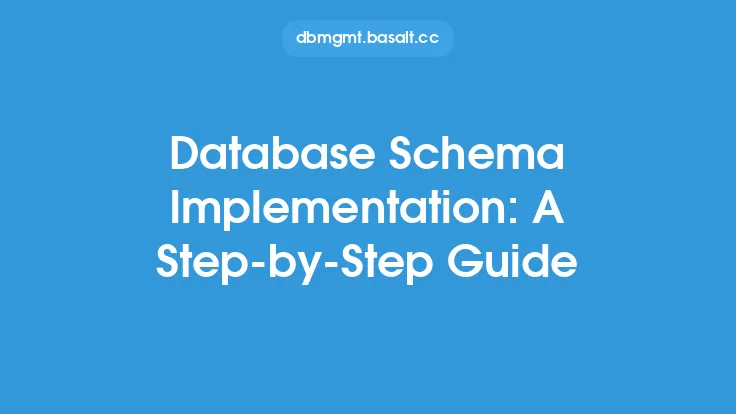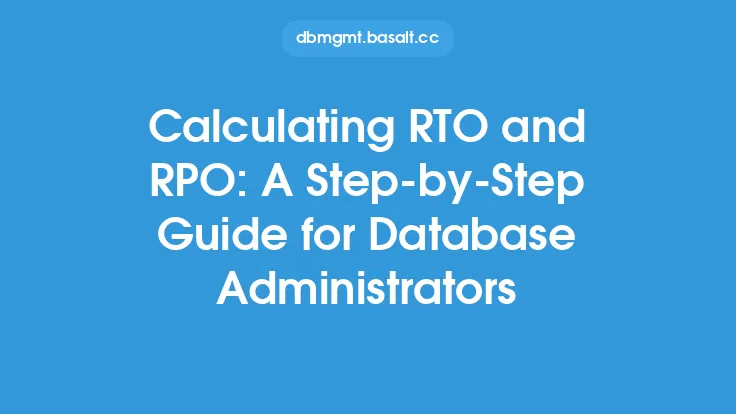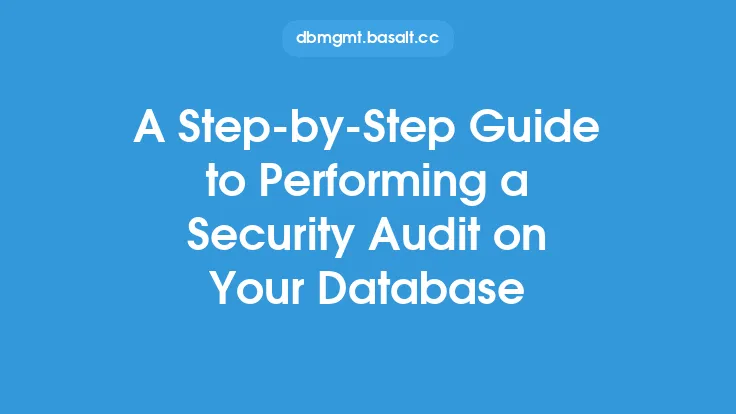Implementing a robust database quality assurance (DBQA) process is crucial for ensuring the accuracy, completeness, and consistency of data within an organization. A well-designed DBQA process helps to identify and mitigate data quality issues, reducing the risk of errors, inconsistencies, and data breaches. In this article, we will provide a step-by-step guide on implementing a DBQA process, focusing on the key components, best practices, and technical considerations.
Introduction to Database Quality Assurance
Database quality assurance is a critical aspect of database administration, as it ensures that the data stored in the database is accurate, complete, and consistent. DBQA involves a set of processes, procedures, and tools that help to identify and mitigate data quality issues, ensuring that the data is reliable, trustworthy, and meets the organization's requirements. A robust DBQA process involves several key components, including data validation, data profiling, data testing, and data monitoring.
Defining Database Quality Assurance Requirements
The first step in implementing a DBQA process is to define the requirements for database quality assurance. This involves identifying the key data quality attributes, such as accuracy, completeness, consistency, and timeliness, and determining the acceptable levels of data quality. The requirements should be based on the organization's business needs, regulatory requirements, and industry standards. It is essential to involve stakeholders from various departments, including business users, data analysts, and IT staff, to ensure that the requirements are comprehensive and aligned with the organization's goals.
Designing a Database Quality Assurance Process
Once the requirements are defined, the next step is to design a DBQA process that meets those requirements. The process should include the following components:
- Data validation: This involves checking the data for accuracy, completeness, and consistency, using techniques such as data profiling, data testing, and data validation rules.
- Data profiling: This involves analyzing the data to identify patterns, trends, and anomalies, using techniques such as data mining, data visualization, and statistical analysis.
- Data testing: This involves testing the data to ensure that it meets the required standards, using techniques such as unit testing, integration testing, and user acceptance testing.
- Data monitoring: This involves continuously monitoring the data to detect any data quality issues, using techniques such as data auditing, data logging, and data alerting.
Implementing a Database Quality Assurance Process
Implementing a DBQA process involves several technical considerations, including:
- Data validation rules: These rules should be defined and implemented to ensure that the data is accurate, complete, and consistent. The rules can be implemented using database constraints, triggers, and stored procedures.
- Data profiling tools: These tools should be used to analyze the data and identify patterns, trends, and anomalies. The tools can include data mining software, data visualization tools, and statistical analysis software.
- Data testing frameworks: These frameworks should be used to test the data and ensure that it meets the required standards. The frameworks can include unit testing frameworks, integration testing frameworks, and user acceptance testing frameworks.
- Data monitoring tools: These tools should be used to continuously monitor the data and detect any data quality issues. The tools can include data auditing software, data logging software, and data alerting software.
Maintaining a Database Quality Assurance Process
Maintaining a DBQA process involves several ongoing activities, including:
- Regular data quality audits: These audits should be performed regularly to ensure that the data is accurate, complete, and consistent.
- Data quality metrics: These metrics should be defined and tracked to measure the data quality and identify areas for improvement.
- Process improvements: The DBQA process should be continuously improved to ensure that it remains effective and efficient.
- Training and awareness: The stakeholders should be trained and aware of the DBQA process and its importance in ensuring data quality.
Best Practices for Database Quality Assurance
Several best practices can be followed to ensure that the DBQA process is effective and efficient. These include:
- Automating data validation and data testing: Automation can help to reduce the risk of human error and improve the efficiency of the DBQA process.
- Using data profiling tools: Data profiling tools can help to identify patterns, trends, and anomalies in the data, improving the effectiveness of the DBQA process.
- Implementing data monitoring: Data monitoring can help to detect data quality issues in real-time, reducing the risk of data breaches and errors.
- Continuously improving the DBQA process: The DBQA process should be continuously improved to ensure that it remains effective and efficient.
Technical Considerations for Database Quality Assurance
Several technical considerations should be taken into account when implementing a DBQA process. These include:
- Database design: The database design should be optimized for data quality, with features such as data normalization, data denormalization, and data indexing.
- Data storage: The data storage should be optimized for data quality, with features such as data compression, data encryption, and data backup.
- Data retrieval: The data retrieval should be optimized for data quality, with features such as data caching, data buffering, and data query optimization.
- Data security: The data security should be optimized for data quality, with features such as access control, authentication, and authorization.
Conclusion
Implementing a robust DBQA process is crucial for ensuring the accuracy, completeness, and consistency of data within an organization. A well-designed DBQA process involves several key components, including data validation, data profiling, data testing, and data monitoring. By following the steps outlined in this article, organizations can implement a DBQA process that meets their requirements and ensures the quality of their data. Remember to continuously improve the DBQA process, automate data validation and testing, and use data profiling tools to ensure the effectiveness and efficiency of the DBQA process.





